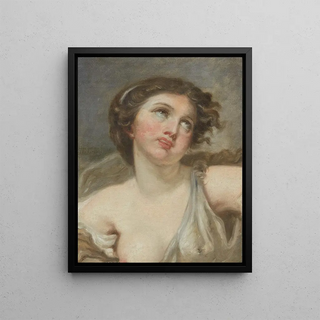Art print | Innocence - Jean-Baptiste Greuze Source: Reproduction | Innocence - Jean-Baptiste Greuze


View from behind

Frame (optional)
In the fascinating universe of art, some works transcend time and space, captivating the gaze and the minds of viewers. "Innocence" by Jean-Baptiste Greuze is a perfect illustration of this. This canvas, created in the 18th century, embodies a poetic and touching vision of childhood, where the purity and fragility of human innocence are highlighted. The artist, through this painting, invites us to contemplate the ephemeral beauty of youth while engaging us in a reflection on human nature and its emotions. The art print Innocence - Jean-Baptiste Greuze allows us to rediscover this iconic work, offering a gateway to a bygone era while remaining strikingly relevant.
Style and uniqueness of the work
Greuze's style is distinguished by its ability to capture the emotional nuances of the characters he depicts. In "Innocence," the delicacy of the features and the subtlety of the colors testify to undeniable technical mastery. The faces, imbued with poignant expressiveness, seem to tell stories, evoking feelings of tenderness and vulnerability. The light, skillfully orchestrated, plays a crucial role in the composition, illuminating the child's face while creating an intimate atmosphere. This painting also stands out for its use of contrasts, where shadow and light meet to emphasize details, making each element lively. Greuze thus manages to establish a dialogue between the subject and the viewer, inviting us to share a suspended moment in time.
The artist and his influence
Jean-Baptiste Greuze, an emblematic figure of the rococo movement, knew how to mark his era with his innovative approach to painting. Born in 1725, he established himself as one of the most appreciated artists of his time, both by the nobility and the people. His style, often associated with an increased sensitivity to human emotions, influenced many artists, both contemporaries and successors. Greuze also contributed to redefining portraiture and genre scenes, emphasizing the psychology of the characters. His works, rich in details and in

Matte finish

View from behind

Frame (optional)
In the fascinating universe of art, some works transcend time and space, captivating the gaze and the minds of viewers. "Innocence" by Jean-Baptiste Greuze is a perfect illustration of this. This canvas, created in the 18th century, embodies a poetic and touching vision of childhood, where the purity and fragility of human innocence are highlighted. The artist, through this painting, invites us to contemplate the ephemeral beauty of youth while engaging us in a reflection on human nature and its emotions. The art print Innocence - Jean-Baptiste Greuze allows us to rediscover this iconic work, offering a gateway to a bygone era while remaining strikingly relevant.
Style and uniqueness of the work
Greuze's style is distinguished by its ability to capture the emotional nuances of the characters he depicts. In "Innocence," the delicacy of the features and the subtlety of the colors testify to undeniable technical mastery. The faces, imbued with poignant expressiveness, seem to tell stories, evoking feelings of tenderness and vulnerability. The light, skillfully orchestrated, plays a crucial role in the composition, illuminating the child's face while creating an intimate atmosphere. This painting also stands out for its use of contrasts, where shadow and light meet to emphasize details, making each element lively. Greuze thus manages to establish a dialogue between the subject and the viewer, inviting us to share a suspended moment in time.
The artist and his influence
Jean-Baptiste Greuze, an emblematic figure of the rococo movement, knew how to mark his era with his innovative approach to painting. Born in 1725, he established himself as one of the most appreciated artists of his time, both by the nobility and the people. His style, often associated with an increased sensitivity to human emotions, influenced many artists, both contemporaries and successors. Greuze also contributed to redefining portraiture and genre scenes, emphasizing the psychology of the characters. His works, rich in details and in






